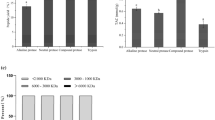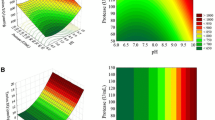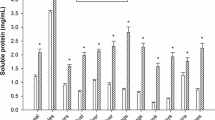Abstract
The objective of this study was to establish the suitable conditions for pea protein hydrolysis using the response surface methodology (RSM). The antioxidant hydrolysates produced by proteases from Bacillus licheniformis LBA 46 and commercial Alcalase 2.4L were compared. The hydrolysis conditions, pH value (10) and enzyme concentration (100 U/mL) were selected as the main processing conditions for the hydrolysis. The experimental values for 2,2-diphenyl-1-picrylhydrazyl (DPPH) radical scavenging, oxygen radical absorbance capacity (ORAC), and ferric reducing antioxidant power (FRAP) under the chosen conditions were 3.64, 568.7 and 9.18 Trolox equivalent/g of protein hydrolysates (TE µmol/g) for LBA protease hydrolysates and 3.77, 719.67 and 9.17 TE µmol/g for Alcalase 2.4L hydrolysates, respectively. Compared to the non-hydrolyzed pea protein, the antioxidant activity measured in terms of DPPH and FRAP was reduced, however, the antioxidant activity measured by ORAC assay, was improved. The LBA protease showed similar action to Alcalase 2.4L, demonstrating its potential use.


Similar content being viewed by others
References
Aguilar JGS, Castro RJS, Sato HH (2018) Optimization of the enzymatic hydrolysis of rice protein by different enzymes using the response surface methodology. 3 Biotech 8:1–9
Amiza MA, Kong YL, Faazaz AL (2012) Effects of degree of hydrolysis on physicochemical properties of Cobia (Rachycentron canadum) frame hydrolysate. Int Food Res J 19:199–206
Benzie IFF, Strain JJ (1996) The ferric reducing ability of plasma (FRAP) as a measure of “antioxidant power”: the FRAP Assay. Anal Biochem 239:70–76
Bougatef A, Hajji M, Balti R, Lassoued I, Triki-Ellouz Y, Nasri M (2009) Antioxidant and free radical-scavenging activities of smooth hound (Mustelus mustelus) muscle protein hydrolysates obtained by gastrointestinal proteases. Food Chem 114:1198–1205
Boye J, Zare F, Pletch A (2010) Pulse proteins: processing, characterization, functional properties and applications in food and feed. Food Res Int 43:414–431
Cao W, Zhang C, Ji H, Hao J (2012) Optimization of peptic hydrolysis parameters for the production of angiotensin I-converting enzyme inhibitory hydrolysate from Acetes chinensis through Plackett-Burman and response surface methodological approaches. J Sci Food Agric 92:42–48
Castro RJS, Sato HH (2014a) Advantages of an acid protease from Aspergillus oryzae over commercial preparations for production of whey protein hydrolysates with antioxidant activities. J Food Process 3:58–65
Castro RJS, Sato HH (2014b) Production and biochemical characterization of protease from Aspergillus oryzae: an evaluation of the physical-chemical parameters using agroindustrial wastes as supports. Biocatal Agric Biotechnol 3:20–25
Castro RJS, Sato HH (2014c) Comparison and synergistic effects of intact proteins and their hydrolysates on the functional properties and antioxidant activities in a simultaneous process of enzymatic hydrolysis. Food Bioprod Process 92:80–88
Castro RJS, Sato HH (2015) A response surface approach on optimization of hydrolysis parameters for the production of egg white protein hydrolysates with antioxidant activities. Biocatal Agric Biotechnol 4:1 55–62
Chao D, Jung F, Aluko RE (2018) Physicochemical and functional properties of high pressure-treated isolated pea protein. Innov Food Sci Emerg Technol 45:179–185
Charney J, Tomarelli RM (1947) A colorimetric method for the determination of the proteolytic activity of duodenal juice. J Biol Chem 171:501–505
Contesini FJ (2014) Production, characterization and application of proteases from Bacillus sp. São Paulo, Brazil: School of Food Engineering, University of Campinas, Phd thesis
Contreras MM, Hernández-Ledesma B, Amigo L, Martín-Álvarez PJ, Recio I (2011) Production of antioxidant hydrolyzates from a whey protein concentrate with thermolysin: optimization by response surface methodology. LWT-Food Sci Technol 44:9–15
Costa GED, Queiroz-Monici KDS, Reis SMPM, Oliveira AC (2006) Chemical composition, dietary fibre and resistant starch contents of raw and cooked pea, common bean, chickpea and lentil legumes. Food Chem 94:327–330
Dahl WJ, Foster LM, Tyler RT (2012) Review of the health benefits of peas (Pisum sativum L.). Br J Nutr 108:3–10
Dávalos A, Gómez-Cordovés C, Bartolomé B (2004) Extending applicability of the oxygen radical absorbance capacity (ORAC-fluorescein) assay. J Agric Food Chem 52:48–54
Dean RT, Hunt JV, Grant AJ, Yamamoto Y, Niki E (1991) Free radical damage to proteins: The influence of relative delocalization of radical generation, antioxidants, and target proteins. Free Radic Biol Med 11:161–168
Eftekharzadeh B, Khodagholi F, Abdi A, Maghsoudi N (2010) Alginate protects NT2 neurons against H2O2-induced neurotoxicity. Carbohydr Polym 79:1063–1072
Elias RJ, Kellerby SS, Decker EA (2008) Antioxidant activity of proteins and peptides. Crit Rev Food Sci Nutr 48:430–441
Felix M, Perez-Puyana V, Romero A, Guerrero A (2017) Development of thermally processed bioactive pea protein gels: Evaluation of mechanical and antioxidant properties. Food Bioprod Process 101:74–83
Gauthier S, Pouliot Y (2003) Functional and biological properties of peptides obtained by enzymatic hydrolysis of whey proteins. J Dairy Sci 86:E78–E87
Girgih AT, Chao D, Lin L, He R, Jung S, Aluko RE (2015) Enzymatic protein hydrolysates from high pressure-pretreated isolated pea proteins have better antioxidant properties than similar hydrolysates produced from heat pretreatment. Food Chem 188:510–516
Granato D, Shahidi F, Wrolstad R, Kilmartin P, Melton LD, Hidalgo FJ, Miyashita K, Van Camp J, Alasalvar C, Ismail AB, Elmore E, Birch GG, Charalampopoulos D, Astley SB, Pegg R, Zhou P, Finglas P (2018) Antioxidant activity, total phenolics and flavonoids contents: Should we ban in vitro screening methods? Food Chem 264:471–475
Ha M, Bekhit A, Carne A, Hopkins DL (2012) Characterization of commercial papain, bromelain, actinidin and zingibain protease preparations and their activities toward meat proteins. Food Chem 134:95–105
Ha M, Bekhit A, Carne A, Hopkins DL (2013) Comparison of the proteolytic activities of new commercially available bacterial and fungal proteases toward meat proteins. J Food Sci 78:170–177
Hartree EF (1972) Determination of protein: a modification of the lowry methods that gives a linear photometric response. Anal Biochem 48:422–427
Hattori M, Yamaji-Tsukamoto K, Kumagai H, Feng Y, Takahashi K (1998) Antioxidative activity of soluble elastin peptides. J Agric Food Chem 46:2167–2170
Hood-Niefer SD, Warkentin TD, Chibbar RN, Vandenberg A, Tyler RT (2012) Effect of genotype and environment on the concentrations of starch and protein in, and the physicochemical properties of starch from, field pea and fababean. J Sci Food Agric 92:141–150
Kouris-Blazos A, Belski R (2016) Health benefits of legumes and pulses with a focus on Australian sweet lupins. Asia Pac J Clin Nutr 25:1–17
Morales-Medina R, Pérez-Gálvez R, Guadix A, Guadix EM (2017) Multiobjective optimization of the antioxidant activities of horse mackerel hydrolysates produced with protease mixtures. Process Biochem 52:149–158
Nesterenko A, Alric I, Silvestre F, Durrieu V (2013) Vegetable proteins in microencapsulation: a review of recent interventions and their effectiveness. Ind Crops Prod 42:469–479
Peričin D, Radulovic-Popovic L, Vaštag Z, Madarev-Popovic S, Trivic S (2009) Enzymatic hydrolysis of protein isolate from hull-less pumpkin oil cake: application of response surface methodology. Food Chem 115:753–757
Reinkensmeier A, Bußler S, Schlüter O, Rohn S, Rawel HM (2015) Characterization of individual proteins in pea protein isolates and air classified samples. Food Res Int 76:160–167
Rival SG, Boeriu CG, Wichers HJ (2001) Caseins and casein hydrolysates. 2. Antioxidative properties and relevance to lipoxygenase inhibition. J Agri Food Chem 49:295–302
Schlimme E, Meisel H (1995) Bioactive peptides derived from milk proteins. Structural, physiological and analytical aspects. Nahrung 39:1–20
Tamm F, Herbst S, Brodkorb A, Drusch S (2016) Functional properties of pea protein hydrolysates in emulsions and spray-dried microcapsules. Food Hydrocoll 58:204–214
Tian M, Fang B, Jiang L, Guo H, Cui JY (2015) Structure-activity relationship of a series of antioxidant tripeptides derived from β-Lactoglobulin using QSAR modeling. Dairy Sci Technol 176:1815–1833
Tironi VA, Anon MC (2010) Amaranth proteins as a source of antioxidant peptides: effect of proteolysis. Food Res Int 43:315–322
Tsou MJ, Kao FJ, Tseng CK, Chiang WD (2010) Enhancing the anti-adipogenic activity of soy protein by limited hydrolysis with flavourzyme and ultrafiltration. Food Chem 122:243–248
Vaštag Z, Popovic L, Popović S, Krimer V, Peričin D (2010) Hydrolysis of pumpkin oil cake protein isolate and free radical scavenging activity of hydrolysates: influence of temperature, enzyme/substrate ratio and time. Food Bioprod Process 88:277–282
Wiriyaphan C, Chitsomboon B, Yongsawadigul J (2012) Antioxidant activity of protein hydrolysates derived from threadfin bream surimi byproducts. Food Chem 132:104–111
Zhu W, Sun S, Yang F, Zhou K (2017) Purification and characterization of antioxidative peptides prepared from pea protein with strong inhibitory activity on lipid oxidation. React Oxyg Species 3:208–217
Zou TB, He TP, Li HB, Tang HW, Xia EQ (2016) The structure-activity relationship of the antioxidant peptides from natural proteins. Molecules 21:1–14
Author information
Authors and Affiliations
Corresponding author
Ethics declarations
Conflict of interest
The authors declare that they have no conflict of interest.
Additional information
Publisher’s Note
Springer Nature remains neutral with regard to jurisdictional claims in published maps and institutional affiliations.
Rights and permissions
About this article
Cite this article
Aguilar, J.G.S., de Castro, R.J.S. & Sato, H.H. Production of Antioxidant Peptides from Pea Protein Using Protease from Bacillus licheniformis LBA 46. Int J Pept Res Ther 26, 435–443 (2020). https://doi.org/10.1007/s10989-019-09849-9
Accepted:
Published:
Issue Date:
DOI: https://doi.org/10.1007/s10989-019-09849-9




